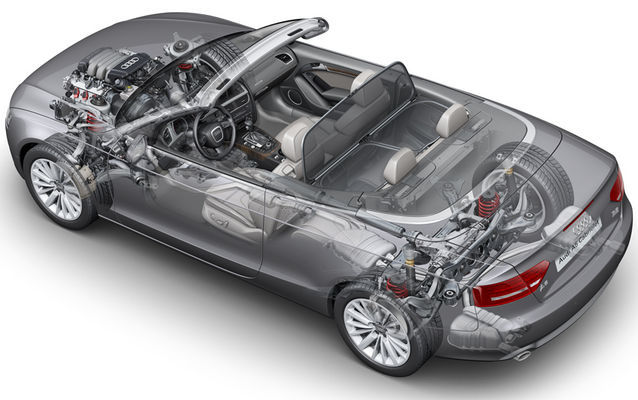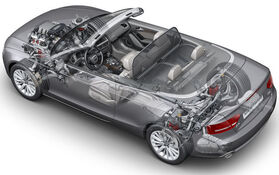Audi A5/S5 Cabriolet – State of the art technology in spades
In our article on the new A5/S5 Cabriolet models, we introduced a few of this car’s technical features. Here are some additional system details.
The S tronic gearbox
Developed by Audi, this dual-clutch transmission was initially called DSG. Now known as S tronic, its latest version offers seven speeds. It is made up of two partial gearboxes and is paired with two clutches that each control different gears. The outer clutch transmits power to the pinions of the odd-numbered gears (1, 3, 5 and 7) through a solid shaft. A hollow shaft revolves around the solid shaft. It is connected to the second clutch, which is integrated into the first clutch, and operates the pinions for the even-numbered gears (2, 4 and 6) as well as reverse.
The two partial gearboxes are constantly active, but only one transmits the engine torque. When the driver accelerates in third gear, for example, fourth gear is already engaged in the second partial gearbox; the gear change is made by changing the clutch. The mecatronic feature, a compact unit made up of calculators and hydraulic regulators, controls all the gear changes and the clutches with extreme precision, including parking manoeuvres down the centimetre.
The quattro system: More refined than ever
This transmission is coupled to the legendary Quattro system. From the gearbox output shaft, power is transmitted to the Quattro full-time all-wheel drive, which distributes it in two directions. With regular distribution, sixty per cent is sent to the rear-axle differential and forty per cent to the front-axle differential. When one wheel skids, the mechanical central differential very quickly directs the majority of the power to the axle that has the best traction. Thus, it is possible to transmit 85 percent of the power to the rear axle or, at most, 65 percent to the front axle.
Although the Quattro is recognized as the most efficient system, the engineers concocted an even more sophisticated version: the new sport differential, available as an option, which provides continuously variable distribution of power between the rear wheels.
The model with Quattro transmission and sport differential directs the majority of the torque to the outer rear wheel in turns, which is how the system counteracts the tendency to oversteer or understeer even before it begins, making the ride even more dynamic. Thanks to its extremely fast reactions (less than 100 milliseconds), the sport differential is even more spontaneous than ESP.
This represents an evolution of the traditional Quattro transmission. The classical differential has been completed on each side by a planetary gear unit that turns ten percent faster than the wheel’s input shaft. Each planetary gear unit is made up of two axle pinions and a ring gear, which are all offset.
A multi-plate clutch, engaged by an electro-hydraulic control and bathed in oil, activates the input shaft and the faster-turning planetary gear unit. Once engaged, the clutch rotates the drive wheel at a faster speed than that of the planetary gear unit. The result is additional torque on the outer drive wheel in turns and less torque on the opposite wheel through the differential. Thus, it is possible to send almost all of the torque to a single wheel. The difference in torque between the two opposite wheels can amount to a maximum of 1,800 N m.
This mechanism’s effectiveness stems from the software developed by Audi to control it. Taking into account the turning angle, yaw angle, lateral acceleration, vehicle speed and other information, the computer continuously and instantly calculates the ideal torque distribution for any situation.
The functions of the sport differential can also be adapted according to the driver’s wishes through the control module that serves to regulate several of the settings offered on certain models. In “comfort mode,” a safe ride and vehicle handling are the uncontested priorities, and acceleration and deceleration are very well-cushioned. In “auto” mode, all of the functions are programmed for perfect balance.
Finally, in “dynamic” mode, where the sport differential maximizes the benefits of heightened performance, the emphasis is on agility. Handling during gear changes is as agile as it is controlled.
These cars also feature all of the other electronic driving aids offered by the cars in this category.










